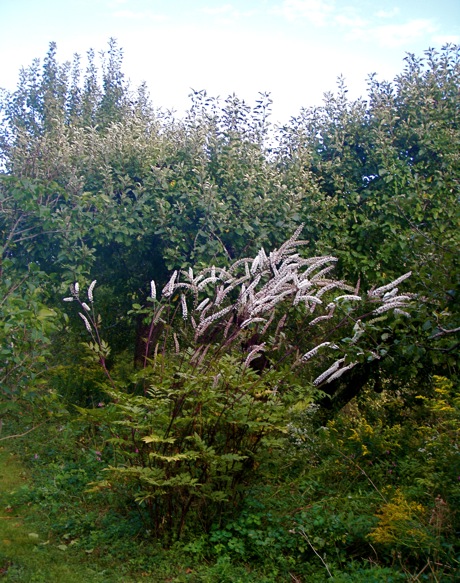Yesterday afternoon’s garden work was all in tight focus: harvesting the endless beans, sorting as I went; thinning and transplanting young beets and greens; deadheading hardy annuals. Yet hour after hour scarcely looking up, I could still hear the size of the garden, soft buzzing nearby, bright chirping around the feeder, territorial shouts all over – hummingbirds have really big lungs.
I could smell it, too. No matter where I was, no matter what was under my nose, there was the perfume of late summer’s fragrance factory, Cimicifuga racemosa (or Actaea racemosa, if you want to be au courant), aka black snakeroot, bugbane, black cohosh and fairy candles.

The clump of black snakeroot is down beyond the lower garden, nestled against the apple tree hedge/edge, but the fragrance is so intense it floats a very long way.
When I planted it, years ago, it was Cimicifuga racemosa ‘Atropurpurea.’ Now, without my having to do anything, it’s Actaea racemosa (or possibly A. simplex) var. atropurpurea. Or maybe not. The nomenclatural tangle growing around these plants defies all but a botanist’s understanding and I’m not sure about them, either.
What matters from the gardener’s point of view is that they’re gorgeous, almost trouble free, and as I seem to have mentioned before, fantastically fragrant.
Some authorities describe A. racemosa, a native of moist North American woodlands, as the species that smells disagreeable. If so, that would be a big help; telling one common Actaea from another is – let’s just say challenging.
Unfortunately, many other authorities say racemosa is, like other species, delightfully fragrant.* It’s probably one of those deals where beauty is in the nose of the smeller, but everyone agrees on the visual value: snakeroot is a must for any gardener who has the space and place. (They’re big, and they do need partial shade.)
In addition to the fragrance, snakeroots offer a kind of architectural twofer: first a bush, then a fountain. From spring to midsummer the plants are reasonably compact, with many stems of large compound leaves that are lovely enough in themselves to warrant a place in the garden.

Typical snakeroot leaf, this one less purple than it would be if the plant got more light and more moisture.
Snakeroot is slow to get going, but it grows from spreading rhizomes and once it takes hold a healthy plant can easily be a squarish mound 4 or 5 feet in diameter. Then in midsummer, transformation! Suddenly there are flowering stems that pull the height up to 6 or 8 feet, and they’re as close as don’t matter to naked from the point of emergence to the big plumes of bottlebrush flowers. A dark backgound shows them off best, but even with light behind them they seem to float unmoored, far above the foliage.
Did I mention they’re fragrant?
Growing Snakeroot
1) The ideal spot is fertile, moist, well drained and in partial shade, but the spiffy black leaved cultivars like ‘Hillside Black Beauty’ and ‘Chocoholic’ need a fair amount of bright light – think full northeast exposure – to keep their intense color.
2) In my experience, these plants are tough. Even though they’re moisture loving, they can survive considerable drought – looking awful, admittedly – and come back strong as ever when conditions improve. But not until they’re established. For the first year or two, it’s essential to provide water if nature does not.
3) Bugs don’t like bugbane and it seldom gets diseased. Rust is the most common problem and can be severe if the plant is already stressed by drought. It would be convenient if Actaeas did well in wetlands, but standing moisture leads to root rot.
4) In undisturbed open woodland, snakeroot self-sows and can form large colonies. YAY!
…or sort of yay; you do have to be patient. Seeds need a warm/cold/warm cycle to sprout and seldom germinate until the second spring after falling. New plants are tiny and can remain nearly invisible for a couple of years, which is why the undisturbed part is important. After the plants are visible, expect to wait another couple of years before they start blooming.
5.) Transplanting small plants is easy, dividing big ones is not; violent root disturbance tends to set them back. Fortunately, they seldom need dividing. Like peonies they can stay in place for a couple of decades without developing dead centers.
* Powerful perfume is a two edged sword; snakeroot is a plein air plant. Bring it in as a bouquet and the smell is indeed strong enough to act as bug repellant.
Medical Note: If you try googling, it doesn’t take long to be deep in the weeds of herbal menopause symptom relievers. Most advocates call the plant black cohosh, perhaps because bugbane and fairy candles present obvious problems and snakeroot is just one small step away from snake oil. The few double blind studies I saw cited in my very brief tour of the terrain found it generally harmless but not notably efficacious. (The possible liver damage problem may or may not be a result of adulterated products.)


